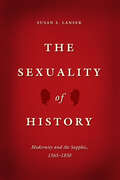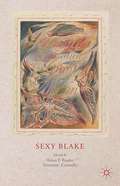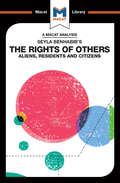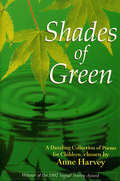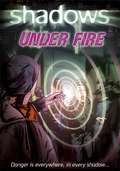- Table View
- List View
The Sexuality of History: Modernity and the Sapphic, 1565-1830
by Susan S. LanserThe period of reform, revolution, and reaction that characterized seventeenth- and eighteenth-century Europe also witnessed an intensified interest in lesbians. In scientific treatises and orientalist travelogues, in French court gossip and Dutch court records, in passionate verse, in the rising novel, and in cross-dressed flirtations on the English and Spanish stage, poets, playwrights, philosophers, and physicians were placing sapphic relations before the public eye. In The Sexuality of History, Susan S. Lanser shows how intimacies between women became harbingers of the modern, bringing the sapphic into the mainstream of some of the most significant events in Western Europe. Ideas about female same-sex relations became a focal point for intellectual and cultural contests between authority and liberty, power and difference, desire and duty, mobility and change, order and governance. Lanser explores the ways in which a historically specific interest in lesbians intersected with, and stimulated, systemic concerns that would seem to have little to do with sexuality. Departing from the prevailing trend of queer reading whereby scholars ferret out hidden content in “closeted” texts, Lanser situates overtly erotic representations within wider spheres of interest. The Sexuality of History shows that just as we can understand sexuality by studying the past, so too can we understand the past by studying sexuality.
The Sexuality of History: Modernity and the Sapphic, 1565-1830
by Susan S. LanserThe period of reform, revolution, and reaction that characterized seventeenth- and eighteenth-century Europe also witnessed an intensified interest in lesbians. In scientific treatises and orientalist travelogues, in French court gossip and Dutch court records, in passionate verse, in the rising novel, and in cross-dressed flirtations on the English and Spanish stage, poets, playwrights, philosophers, and physicians were placing sapphic relations before the public eye. In The Sexuality of History, Susan S. Lanser shows how intimacies between women became harbingers of the modern, bringing the sapphic into the mainstream of some of the most significant events in Western Europe. Ideas about female same-sex relations became a focal point for intellectual and cultural contests between authority and liberty, power and difference, desire and duty, mobility and change, order and governance. Lanser explores the ways in which a historically specific interest in lesbians intersected with, and stimulated, systemic concerns that would seem to have little to do with sexuality. Departing from the prevailing trend of queer reading whereby scholars ferret out hidden content in “closeted” texts, Lanser situates overtly erotic representations within wider spheres of interest. The Sexuality of History shows that just as we can understand sexuality by studying the past, so too can we understand the past by studying sexuality.
The Sexuality of History: Modernity and the Sapphic, 1565-1830
by Susan S. LanserThe period of reform, revolution, and reaction that characterized seventeenth- and eighteenth-century Europe also witnessed an intensified interest in lesbians. In scientific treatises and orientalist travelogues, in French court gossip and Dutch court records, in passionate verse, in the rising novel, and in cross-dressed flirtations on the English and Spanish stage, poets, playwrights, philosophers, and physicians were placing sapphic relations before the public eye. In The Sexuality of History, Susan S. Lanser shows how intimacies between women became harbingers of the modern, bringing the sapphic into the mainstream of some of the most significant events in Western Europe. Ideas about female same-sex relations became a focal point for intellectual and cultural contests between authority and liberty, power and difference, desire and duty, mobility and change, order and governance. Lanser explores the ways in which a historically specific interest in lesbians intersected with, and stimulated, systemic concerns that would seem to have little to do with sexuality. Departing from the prevailing trend of queer reading whereby scholars ferret out hidden content in “closeted” texts, Lanser situates overtly erotic representations within wider spheres of interest. The Sexuality of History shows that just as we can understand sexuality by studying the past, so too can we understand the past by studying sexuality.
The Sexuality of History: Modernity and the Sapphic, 1565-1830
by Susan S. LanserThe period of reform, revolution, and reaction that characterized seventeenth- and eighteenth-century Europe also witnessed an intensified interest in lesbians. In scientific treatises and orientalist travelogues, in French court gossip and Dutch court records, in passionate verse, in the rising novel, and in cross-dressed flirtations on the English and Spanish stage, poets, playwrights, philosophers, and physicians were placing sapphic relations before the public eye. In The Sexuality of History, Susan S. Lanser shows how intimacies between women became harbingers of the modern, bringing the sapphic into the mainstream of some of the most significant events in Western Europe. Ideas about female same-sex relations became a focal point for intellectual and cultural contests between authority and liberty, power and difference, desire and duty, mobility and change, order and governance. Lanser explores the ways in which a historically specific interest in lesbians intersected with, and stimulated, systemic concerns that would seem to have little to do with sexuality. Departing from the prevailing trend of queer reading whereby scholars ferret out hidden content in “closeted” texts, Lanser situates overtly erotic representations within wider spheres of interest. The Sexuality of History shows that just as we can understand sexuality by studying the past, so too can we understand the past by studying sexuality.
The Sexuality of History: Modernity and the Sapphic, 1565-1830
by Susan S. LanserThe period of reform, revolution, and reaction that characterized seventeenth- and eighteenth-century Europe also witnessed an intensified interest in lesbians. In scientific treatises and orientalist travelogues, in French court gossip and Dutch court records, in passionate verse, in the rising novel, and in cross-dressed flirtations on the English and Spanish stage, poets, playwrights, philosophers, and physicians were placing sapphic relations before the public eye. In The Sexuality of History, Susan S. Lanser shows how intimacies between women became harbingers of the modern, bringing the sapphic into the mainstream of some of the most significant events in Western Europe. Ideas about female same-sex relations became a focal point for intellectual and cultural contests between authority and liberty, power and difference, desire and duty, mobility and change, order and governance. Lanser explores the ways in which a historically specific interest in lesbians intersected with, and stimulated, systemic concerns that would seem to have little to do with sexuality. Departing from the prevailing trend of queer reading whereby scholars ferret out hidden content in “closeted” texts, Lanser situates overtly erotic representations within wider spheres of interest. The Sexuality of History shows that just as we can understand sexuality by studying the past, so too can we understand the past by studying sexuality.
Sexuality, Sociality, and Cosmology in Medieval Literary Texts (The New Middle Ages)
by Jennifer N. Brown Marla SegolExploring the relation between sexuality and cosmology in a variety of literary texts from the tenth to the sixteenth centuries, the essays reveal that medieval authors, whether lay or religious, Christian or Jewish, were grappling with the same sets of questions about sexuality as people are today.
Sexy Blake
by Helen P. Bruder Tristanne ConnollyThis book lays bare numerous sexy Blakes, arguing for both chastity and pornography, violence and domination as well as desire and redemption, and also journeying in the realms of conceptual sex and conceptual art. Fierce tussles over the body in, and the body of, the poet-artist's work celebrate Blakean attractions and repulsions.
Seyla Benhabib's The Rights of Others: Aliens, Residents, and Citizens (The Macat Library)
by Burcu OzcelikIn The Rights of Others, Benhabib argues that the transnational movement of people across the globe has brought to the fore fundamental dilemmas facing liberal democracies: tension between a state’s commitment to universal human rights, and to its sovereign self-determination and its claims to regulate its national borders on the other. Re-conceptualises the boundaries of political membership in liberal democracies instead proposing ‘porous’ borders rather than open ones and a right to ‘just membership,’ advocating cosmopolitan federalism in the tradition of Kant. Banhabib’s work goes to the heart of key issues faced in a world of forced displacement, Brexit, and increased protectionism.
Seyla Benhabib's The Rights of Others: Aliens, Residents, and Citizens (The Macat Library)
by Burcu OzcelikIn The Rights of Others, Benhabib argues that the transnational movement of people across the globe has brought to the fore fundamental dilemmas facing liberal democracies: tension between a state’s commitment to universal human rights, and to its sovereign self-determination and its claims to regulate its national borders on the other. Re-conceptualises the boundaries of political membership in liberal democracies instead proposing ‘porous’ borders rather than open ones and a right to ‘just membership,’ advocating cosmopolitan federalism in the tradition of Kant. Banhabib’s work goes to the heart of key issues faced in a world of forced displacement, Brexit, and increased protectionism.
Shades of Authority: The Poetry of Lowell, Hill and Heaney (Liverpool English Texts and Studies #50)
by Stephen JamesWhat is the relationship between poetry and power? Should poetry be considered a mode of authority or an impotent medium? And why is it that the modern poets most commonly regarded as authoritative are precisely those whose works wrestle with a sense of artistic inadequacy? Such questions lie at the heart of this study, prompting fresh insights into three of the most important poets of recent decades: Robert Lowell, Geoffrey Hill and Seamus Heaney. Through attentive close reading and the tracing of dominant motifs in each writer’s works, James shows how their responsiveness to matters of political and cultural import lends weight to the idea of poetry as authoritative utterance, as a medium for speaking of and to the world in a persuasive, memorable manner. And yet, as James demonstrates, each poet is exercised by an awareness of his own cultural marginality, even by a sense of the limitations and liabilities of language itself.
Shades Of Green
by Anne Harvey John LawrenceA wide-ranging collection of nature poems for children, chosen by Anne Harvey. This is the perfect collection for introducing children to the magic of poetry. Includes poems from Thomas Hardy, Spike Milligan, Laurie Lee, Ian Serraillier, John Betjemen, William Blake, Geoffery Chaucer, Emily Dickinson, Philip Larkin, Helen Dunmore, and many more.
Shades of the Planet: American Literature as World Literature
by Wai Chee Dimock Lawrence BuellIn a globalizing age, studying American literature in isolation from the rest of the world seems less and less justified. But is the conceptual box of the nation dispensable? And what would American literature look like without it?Leading scholars take up this debate in Shades of the Planet, beginning not with the United States as center, but with the world as circumference. This reversed frame yields a surprising landscape, alive with traces of West Africa, Eastern Europe, Iran, Iraq, India, China, Mexico, and Australia. The Broadway musical Oklahoma! has aboriginal antecedents; Black English houses an African syntax; American slavery consorts with the Holocaust; Philip Roth keeps company with Milan Kundera; the crime novel moves south of the border; and R. P. Blackmur lectures in Japan. A national literature becomes haunted by the world when that literature is seen extending to the Pacific, opening up to Islam, and accompanying African-American authors as they travel. Highlighting American literature as a fold in a planet-wide fabric, this pioneering volume transforms the field, redrawing its institutional as well as geographical map.The contributors are Rachel Adams, Jonathan Arac, Homi K. Bhabha, Lawrence Buell, Wai Chee Dimock, Susan Stanford Friedman, Paul Giles, David Palumbo-Liu, Ross Posnock, Joseph Roach, and Eric J. Sundquist.
Shades of the Planet: American Literature as World Literature (PDF)
by Wai Chee Dimock Lawrence BuellIn a globalizing age, studying American literature in isolation from the rest of the world seems less and less justified. But is the conceptual box of the nation dispensable? And what would American literature look like without it?Leading scholars take up this debate in Shades of the Planet, beginning not with the United States as center, but with the world as circumference. This reversed frame yields a surprising landscape, alive with traces of West Africa, Eastern Europe, Iran, Iraq, India, China, Mexico, and Australia. The Broadway musical Oklahoma! has aboriginal antecedents; Black English houses an African syntax; American slavery consorts with the Holocaust; Philip Roth keeps company with Milan Kundera; the crime novel moves south of the border; and R. P. Blackmur lectures in Japan. A national literature becomes haunted by the world when that literature is seen extending to the Pacific, opening up to Islam, and accompanying African-American authors as they travel. Highlighting American literature as a fold in a planet-wide fabric, this pioneering volume transforms the field, redrawing its institutional as well as geographical map.The contributors are Rachel Adams, Jonathan Arac, Homi K. Bhabha, Lawrence Buell, Wai Chee Dimock, Susan Stanford Friedman, Paul Giles, David Palumbo-Liu, Ross Posnock, Joseph Roach, and Eric J. Sundquist.
The Shadow and the Act: Black Intellectual Practice, Jazz Improvisation, and Philosophical Pragmatism
by Walton M. MuyumbaThough often thought of as rivals, Ralph Ellison, James Baldwin, and Amiri Baraka shared a range of interests, especially a passion for music. Jazz, in particular, was a decisive influence on their thinking, and, as The Shadow and the Act reveals, they drew on their insights into the creative process of improvisation to analyze race and politics in the civil rights era. In this inspired study, Walton M. Muyumba situates them as a jazz trio, demonstrating how Ellison, Baraka, and Baldwin’s individual works form a series of calls and responses with each other. Muyumba connects their writings on jazz to the philosophical tradition of pragmatism, particularly its support for more freedom for individuals and more democratic societies. He examines the way they responded to and elaborated on that lineage, showing how they significantly broadened it by addressing the African American experience, especially its aesthetics. Ultimately, Muyumba contends, the trio enacted pragmatist principles by effectively communicating the social and political benefits of African Americans fully entering society, thereby compelling America to move closer to its democratic ideals.
The Shadow and the Act: Black Intellectual Practice, Jazz Improvisation, and Philosophical Pragmatism
by Walton M. MuyumbaThough often thought of as rivals, Ralph Ellison, James Baldwin, and Amiri Baraka shared a range of interests, especially a passion for music. Jazz, in particular, was a decisive influence on their thinking, and, as The Shadow and the Act reveals, they drew on their insights into the creative process of improvisation to analyze race and politics in the civil rights era. In this inspired study, Walton M. Muyumba situates them as a jazz trio, demonstrating how Ellison, Baraka, and Baldwin’s individual works form a series of calls and responses with each other. Muyumba connects their writings on jazz to the philosophical tradition of pragmatism, particularly its support for more freedom for individuals and more democratic societies. He examines the way they responded to and elaborated on that lineage, showing how they significantly broadened it by addressing the African American experience, especially its aesthetics. Ultimately, Muyumba contends, the trio enacted pragmatist principles by effectively communicating the social and political benefits of African Americans fully entering society, thereby compelling America to move closer to its democratic ideals.
The Shadow and the Act: Black Intellectual Practice, Jazz Improvisation, and Philosophical Pragmatism
by Walton M. MuyumbaThough often thought of as rivals, Ralph Ellison, James Baldwin, and Amiri Baraka shared a range of interests, especially a passion for music. Jazz, in particular, was a decisive influence on their thinking, and, as The Shadow and the Act reveals, they drew on their insights into the creative process of improvisation to analyze race and politics in the civil rights era. In this inspired study, Walton M. Muyumba situates them as a jazz trio, demonstrating how Ellison, Baraka, and Baldwin’s individual works form a series of calls and responses with each other. Muyumba connects their writings on jazz to the philosophical tradition of pragmatism, particularly its support for more freedom for individuals and more democratic societies. He examines the way they responded to and elaborated on that lineage, showing how they significantly broadened it by addressing the African American experience, especially its aesthetics. Ultimately, Muyumba contends, the trio enacted pragmatist principles by effectively communicating the social and political benefits of African Americans fully entering society, thereby compelling America to move closer to its democratic ideals.
The Shadow of Death: Literature, Romanticism, and the Subject of Punishment
by Mark CanuelThe Shadow of Death is a timely and ambitious reassessment of English Romantic literature and the unique role it played in one of the great liberal political causes of the modern age. Mark Canuel argues that Romantic writers in Great Britain led one of the earliest assaults on the death penalty and were instrumental in bringing about penal-law reforms. He demonstrates how writers like Percy Bysshe Shelley, Lord Byron, William Wordsworth, and Jane Austen defined the fundamental contradictions that continue to inform today's debates about capital punishment. Celebrated reformers like Sir Samuel Romilly and William Ewart campaigned against the widespread use of death to punish crimes ranging from murder to petty theft, but they were most influential for initiating a system of penalties built upon conflicting motivations and justifications. Canuel examines the ways Romantic poets and novelists magnified these tensions while treating them as uniquely aesthetic opportunities, seized upon contending rationales of punishment to express imaginative power, and revealed how the imagination fueled the new penal code's disturbing vitality. Death-penalty reform, Canuel argues, in fact emerged from a new way of thinking about punishment as a negotiation among rationales rather than a seamless whole, with leniency and severity constantly at odds. He concludes by exploring how Romantic penal reform continues to influence contemporary views about the justice--and injustice--of legal sanctions.
The Shadow of Death: Literature, Romanticism, and the Subject of Punishment
by Mark CanuelThe Shadow of Death is a timely and ambitious reassessment of English Romantic literature and the unique role it played in one of the great liberal political causes of the modern age. Mark Canuel argues that Romantic writers in Great Britain led one of the earliest assaults on the death penalty and were instrumental in bringing about penal-law reforms. He demonstrates how writers like Percy Bysshe Shelley, Lord Byron, William Wordsworth, and Jane Austen defined the fundamental contradictions that continue to inform today's debates about capital punishment. Celebrated reformers like Sir Samuel Romilly and William Ewart campaigned against the widespread use of death to punish crimes ranging from murder to petty theft, but they were most influential for initiating a system of penalties built upon conflicting motivations and justifications. Canuel examines the ways Romantic poets and novelists magnified these tensions while treating them as uniquely aesthetic opportunities, seized upon contending rationales of punishment to express imaginative power, and revealed how the imagination fueled the new penal code's disturbing vitality. Death-penalty reform, Canuel argues, in fact emerged from a new way of thinking about punishment as a negotiation among rationales rather than a seamless whole, with leniency and severity constantly at odds. He concludes by exploring how Romantic penal reform continues to influence contemporary views about the justice--and injustice--of legal sanctions.
The Shadow of Perseus
by Claire HeywoodHistory remembers him as a hero. But the women who knew him best remember a different man...Perseus grows up wanting to be a hero, but he cannot become one if his mother Danae still sees him as a boy. When his stepfather Polydektes casts him away on a voyage across the sea, Perseus is determined to fulfil the great destiny of the son of a god and the grandson of a king. But the line between heroism and monstrosity is thin, and when Perseus attempts to seduce first gentle Medusa and then beautiful Andromeda, before finally reuniting with Danae, they each learn of the dangers of resisting a boy prepared to risk it all for greatness . . .
Shadowing as a Practice in Second Language Acquisition: Connecting Inputs and Outputs (Routledge Research in Language Education)
by Shuhei KadotaShadowing is a theoretically and empirically well-examined method to develop L2 learners’ listening comprehension (input effect); enhance their subvocal rehearsal mechanism in the phonological working memory for learning new words, formula, and constructions (practice effect); simulate some stages of speech production (output effect); and develop metacognitive monitoring and control by their executive working memory (monitoring effect). In Japan and some other Asian countries, shadowing is a well-recognized, popular method of learning English and Japanese as L2, and this book offers the chance for anyone new to this method to benefit. Through the research contained within this book, readers will be armed with detailed and useful accounts of the four effects above (i.e. input, practice, output, and monitoring effects) from a theoretical and empirical viewpoint.
Shadowing as a Practice in Second Language Acquisition: Connecting Inputs and Outputs (Routledge Research in Language Education)
by Shuhei KadotaShadowing is a theoretically and empirically well-examined method to develop L2 learners’ listening comprehension (input effect); enhance their subvocal rehearsal mechanism in the phonological working memory for learning new words, formula, and constructions (practice effect); simulate some stages of speech production (output effect); and develop metacognitive monitoring and control by their executive working memory (monitoring effect). In Japan and some other Asian countries, shadowing is a well-recognized, popular method of learning English and Japanese as L2, and this book offers the chance for anyone new to this method to benefit. Through the research contained within this book, readers will be armed with detailed and useful accounts of the four effects above (i.e. input, practice, output, and monitoring effects) from a theoretical and empirical viewpoint.
Shadows: The Enemy Inside (PDF)
by Paul BlumMatt Merton and Dexter must find the spy. But will one them make a big mistake?
Shadows: Under Fire (PDF)
by Paul BlumIdeal to engage reluctant boy readers aged 10-14. The sky is grey. It is snowing. Everything is silent. Everything is dark. Will Matt Merton make it out of the frozen city alive? Shadows is a gripping, mysterious adventure series supported by clear yet atmospheric black and white illustrations. With a minimum of text on each page, the dramatic stories have been written to encourage boys who are struggling readers, motivating them to pick up a book and start reading. The books are printed on cream paper to support dyslexic readers. Each story follows Matt Merton who works for The Firm, his job is to kill the enemy- the aliens among us.
Shadows: The Enemy Inside (PDF)
by Paul BlumPart of the 'Shadows' series for less able readers, this book is set in the near future, where an alien invasion has left the Earth devastated and a mysterious organisation called The Firm holds power.
Shadows: Loss of Nerve (PDF)
by Paul BlumMatt Merton finds an Enemy and he knows he must stop him. That's his job. But he can't do it. Who can he trust if he can't trust himself? Has Matt really lost his nerve? Shadows is a gripping, mysterious adventure series supported by clear yet atmospheric black and white illustrations.
